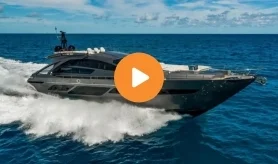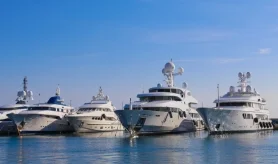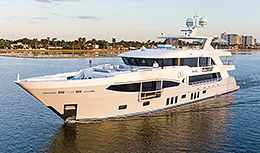- Alaskan Yachts
- Azimut Yachts
- Back Cove Yachts
- Beneteau Yachts
- Benetti Superyachts
- Bertram Yachts
- Boston Whaler
- Broward Yachts
- Buddy Davis Sportfish
- Burger Yachts
- Cabo Yachts
- Catamarans
- Carver Motoryachts
- Center Console
- Chris-Craft Yachts
- Cruisers Yachts
- DeFever Trawlers
- Dufour Sailboats
- Fairline Yachts
- Feadship Yachts
- Ferretti Yachts
- Formula Yachts
- Fountaine Pajot Cats
- Grady-White
- Grand Banks Trawlers
- Hargrave Yachts
- Hatteras Yachts
- Hinckley Picnic Boats
- Horizon Yachts
- Hydra-Sports
- Intrepid Boats
- Jarrett Bay Sportfish
- Jeanneau Yachts
- Kadey-Krogen Trawlers
- Lazzara Yachts
- Lekker Boats
- Luhrs Sportfish
- Marlow Yachts
- Maritimo Yachts
- Marquis Yachts
- McKinna Motoryachts
- Meridian Yachts
- Midnight Express
- MJM Yachts
- Mochi Craft
- Neptunus Motoryachts
- Nordhavn Trawlers
- Nordic Tugs
- Numarine Yachts
- Ocean Alexander Yachts
- Offshore Yachts
- Outer Reef
- Oyster Sailing Yachts
- Pacific Mariner Yachts
- Palmer Johnson Yachts
Joining the Gucci-Loafer Set for A Glimpse of Superyacht Life in Monaco [in the News]
October 3, 2023 2:00 pm
Sanctions imposed on Russian oligarchs don’t seem to have hurt the big-flashy-boat industry
This article was featured on washingtonpost.com in September 2023 and was written by William Booth.
MONTE CARLO — Welcome aboard at the Monaco Yacht Show, where the world’s superyachts are bought and sold. Warning: If you find the excesses of the 0.01 percent triggering, avert your eyes.
The scene here is like a parking lot crammed with water toys that cost a cool collective $4.3 billion.
The technical term for the size of these pleasure craft is “enormous.” The top class — the megayachts — are now 100 meters in length — that’s 328 feet, more than a football field from goal line to goal line. There are dozens of these boats on order.
There’s also talk of gigayachts to come. Asked what a giga might be, a top broker joked: “That would be a repurposed aircraft carrier.”
Have one helipad? Sad. Why not have two?
Jet Skis? The new must-have toy is a submersible.
There are onboard elevators, naturally, to get between the four, five and six decks. Surfaces are clad in lost forests of teak and mahogany with gleaming stainless steel accents. The deckhands are constantly polishing, rubbing, squeegeeing.


You might think superyacht sales would be super down, what with global inflation, a real estate bust in China, threats of recession, trench warfare in Europe and — dare we say it here? — a planetary climate crisis. Surprise. You would be wrong.
Russian oligarchs have traditionally been big buyers of showy yachts, accounting for an estimated 10 percent of sales. Sanctions and the U.S. Justice Department’s Task Force KleptoCapture have taken a bite. A lot of the Russian boats — including the $700 million megayacht Scheherazade, allegedly owned by Vladimir Putin himself — have been seized.
But the world is bigger than Russia — and there are more billionaires than ever.
“The sanctions didn’t affect the industry as much as you might think,” said Bob Denison, a top American broker with new offices in Monaco. He said the orders for “new builds” in European shipyards that were canceled because the buyers were placed on sanction lists were quickly snapped up by others who weren’t.
The problem with the superyacht market today?
“There’s not enough superyachts,” said Jeremy Roche, one of Denison’s directors.
It costs 600 euros ($635) for a day pass to the Monaco Yacht Show. Many well-heeled lookie-loos have come this week to stroll along the blue-carpeted docks and bump into a champagne tent.


And by well-heeled, we mean it. You must take off your shoes to board boats at the show — even if you are the prince of Monaco. So high-end footwear is strewn in front of the gangways, the ubiquitous Gucci loafers jumbled together with sneakers from Dior and Balenciaga that will set you back about $1,000 per pair.
The number of real buyers — the whales — is harder to calculate. A sales rep estimated there might be one buyer for every 100 staff — that’s exhibitors, brokers, deckhands, hostesses, marketers, cleaners, security.
We got an invitation from a friendly publicist to take a tour of Phoenix 2, built by Lürssen shipyard in northern Germany. She’s 90 meters, or 295 feet, with room for 14 guests in seven cabins, attended by a crew of 28 — and on sale for $132 million.
The boat was designed for the “richest man in Poland,” the late Jan Kulczyk, who wanted the interior to resemble an art deco Manhattan penthouse. There’s an Empire State Building vibe, with a lot of black and white — plus a bourbon bar, lap pool, steam sauna, screening room, gym, wine cave, Steinway piano and duplex owners’ cabin.



Henry Smith, a partner at Cecil Wright brokerage, was showing the boat and happy to discuss the evolving market for superyachts — generally, boats more than 24 meters.
Three decades ago, a 40-meter yacht would have been gigantic, he said. Today, those are considered midsize. Of the roughly 1,200 superyachts on order in boatyards, about two dozen are more than 100 meters.
“Boats just get bigger and bigger, with prices going up and up,” he said. “The future looks bright.”
The pace of sales is down a bit from the records of the pandemic years, when the ultrarich sought out superyachts as safe havens. But Smith said this year is still good.
He and his brokerage recently oversaw the sale of superyacht Kismet, originally built for Pakistani American billionaire Shahid Khan, owner of the Jacksonville Jaguars. The boat was on the market for just three months and sold for 149 million euros ($157 million).
The buyers keep coming, but they are changing, the brokers say.
Traditionally, they have been multimillionaires — 99 percent male — who sell their businesses in their mid-60s and want some high-end downtime with family and friends. The trend now is younger, with younger families, who struck it rich, or as Smith called it, experienced “a big liquidity event.”
He said, “I took on a chap who made several billion very quickly,” who wasn’t sure exactly what he wanted, except that he really wanted … something big.


At the boat show, we learned that sometimes it’s impossible to accommodate everything you need on your superyacht.
Tenders — used to ferry owners and guests from ship to shore — have a low profile and can be stored aboard in what the yachting community calls “the garage.” Robert Oakley of Falcon Tenders will sell you Miss Wonderly for $2.19 million. It’s powered by a hybrid diesel-electric engine, which gives you one hour on electric in port. “Think limousine,” he said.
But where do you put the sub?
Ian Sheard, the engineering director of Seamagine, maker of private submarines, explained it to us.
“You got the big white boat, the superyacht, right?” Sheard said. “Then you need the toy hauler.”
Say again?
“The ‘shadow ship’ that follows the superyacht that has all the stuff you can’t fit on the superyacht.”
His submarines cost $4 million to $7 million and can carry two to seven passengers, with over 12,000 drama-free dives so far.
On our tours of superyachts, the guides often spoke of the boats’ “understated glamour.” But the glamour seemed bluntly stated, which was kind of the point?
Some interiors had a look and feel of a neutral-color Four Seasons. Others brought to mind a Vegas suite for a high-roller.

Aboard the $110 million Kensho, the publicist said that the owner (Udo Müller, chief executive of Ströer Media), wanted “a villa at sea.”
She described it as “more Zen, more calm.”
The kind of calm that three onboard bars might provide.
An older, smaller superyacht can be had for as little as $10 million — the price of an upscale home in Los Angeles or London. But if you are not ready to buy, many of the boats are used by their owners for only a few weeks in the high season and are otherwise available for charter.
To rent the Phoenix 2 costs a base price of $1.22 million per week. That doesn’t include fuel, food, drink, taxes, mooring and dock fees or tips — so call it $1.6 million. We had to ask a couple of times about the bill and were told to keep adding zeros.
It’s the fuel that gets you. A 50-meter yacht making a fast run between Monaco and St. Tropez might burn through $35,000 of diesel.
And even if you don’t go anywhere, a mooring ball or a slip at a primo port can cost thousands of dollars a night.
There was some talk at the Monaco Yacht Show about sustainability — about new green fuels, more gentle anchoring — but it was a sideshow.
Smith, the super broker, put it this way. “Green yachting is mostly a fallacy,” he said, adding, “no illusion, these things pollute.” Though you can mitigate the damage a bit.
He suggested anyone chartering a superyacht for a week “go out and plant a lot of trees.”





![Joining the Gucci-Loafer Set for A Glimpse of Superyacht Life in Monaco [in the News]](https://cdn.denisonyachtsales.com/wp-content/uploads/2023/10/Web-Image-Resize-Template-1200-x-600-Secondary-GP-2023-10-03T125504.169.png)
![Joining the Gucci-Loafer Set for A Glimpse of Superyacht Life in Monaco [in the News] Share on Facebook](https://cdn.DenisonYachtSales.com/images/share1.svg)
![Joining the Gucci-Loafer Set for A Glimpse of Superyacht Life in Monaco [in the News] Share via Email](https://cdn.DenisonYachtSales.com/images/share2.svg)
![Joining the Gucci-Loafer Set for A Glimpse of Superyacht Life in Monaco [in the News] Share on Twitter](https://cdn.DenisonYachtSales.com/images/share3.svg)


